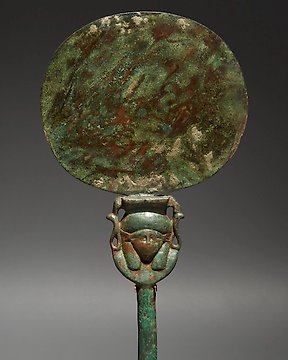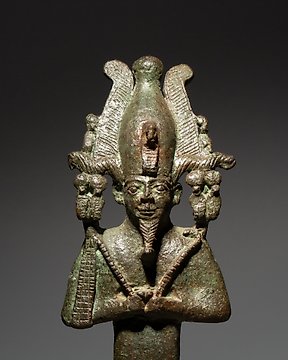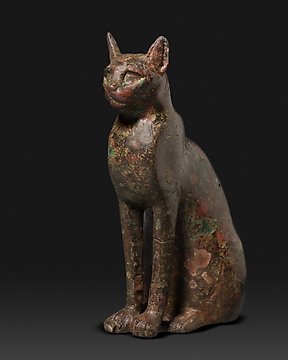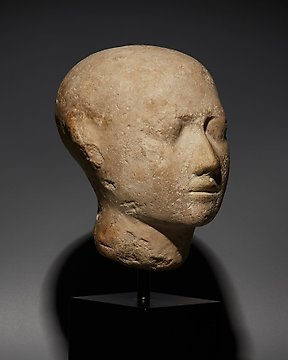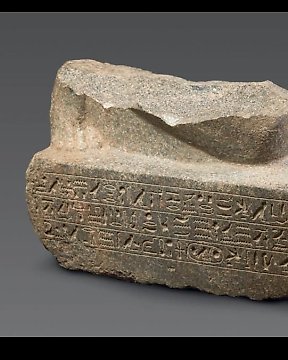Altägyptisch Bronze Pantheistischer apotropäischer Gott Pamen; mit Anubis, Bes, Hepry, Horus. 11,2 cm H. Spanische
Nr. 84916289
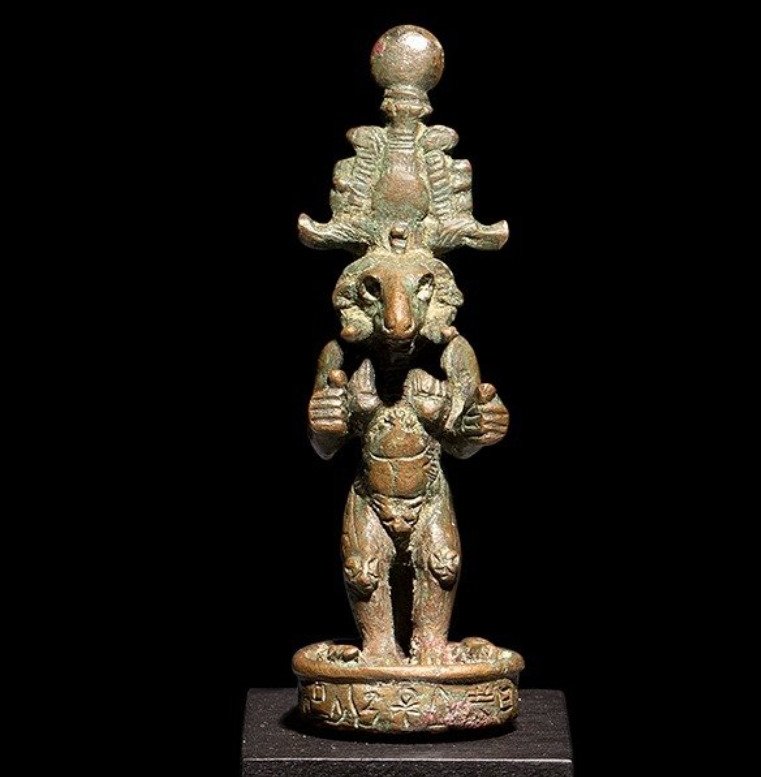
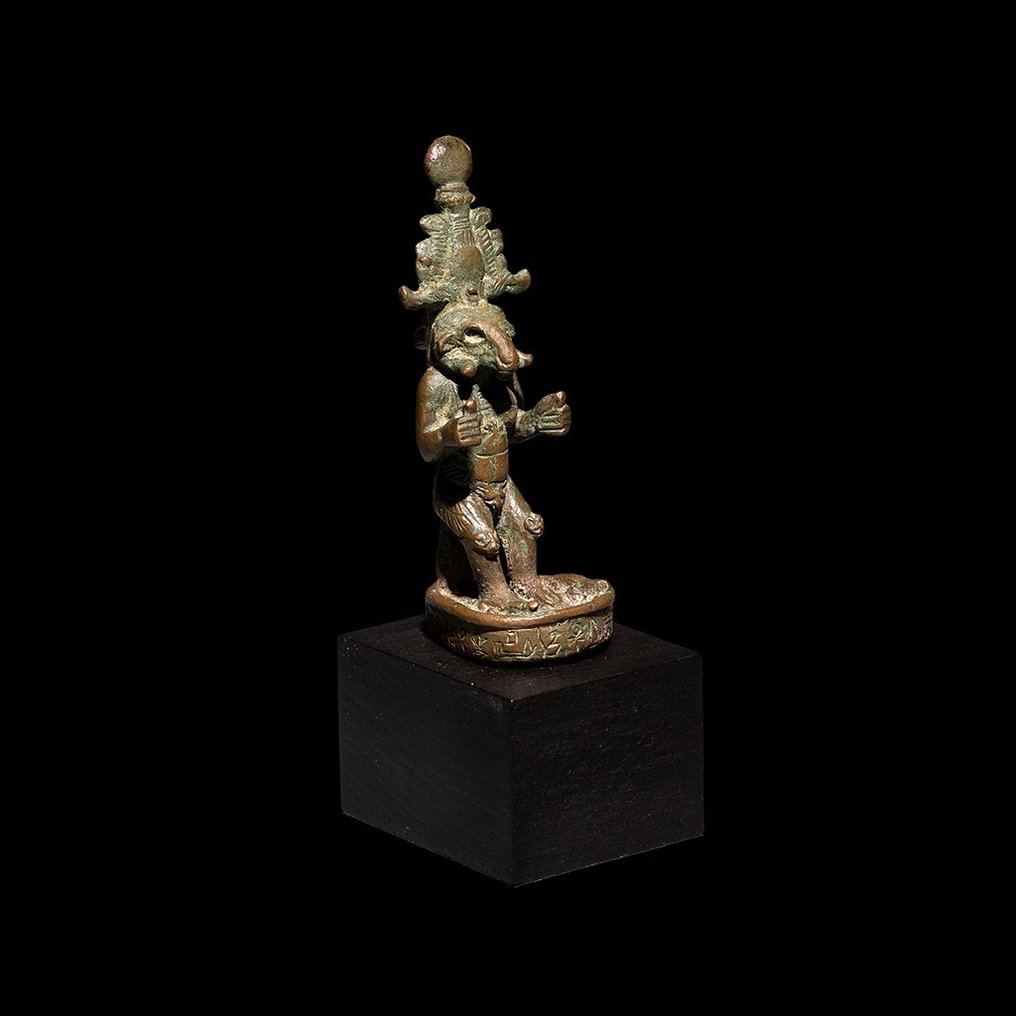

Sculpture of the pantheistic apotropaic god Pamen
With Horus, Hepry, Bes, Harpokrates, Amen, Anubis gods.
Translate hieroglyphic : "May Pamen give life to Padihor son of Padiamon".
- multiple god with inscription -
- masterpiece unique -
- very rare -
CULTURE: Ancient Egypt
PERIOD: Late Period, 664 – 332 BC
MATERIAL: Solid Bronze
DIMENSIONS: Height 11.2 cm with the spike; 9.5 cm without
PROVENANCE: Private collection Brussels, Belgium, 1960 - 1970. Ex. J. Billen, Brussels.
CONDITION: Intact. Very good condition with fine details and complete hieroglyphic inscription at the base of the representation.
DESCRIPTION:
Sculpture of a multiple or pantheistic god formed from different elements of several gods. On a circular base with a hieroglyphic inscription that translates: "May Pamen give life to Padihor son of Padiamon". It presents a semi-erect human body, with a clear influence between the body of the god Bes, but more stylized, and that of the child Horus. It has the head of a ram carrying a headdress on its head, the Atef crown, composed of the White crown of Upper Egypt, topped with a solar disc, flanked by two ostrich feathers, together with an upright cobra with a solar disc on each side, and a cobra in the front part of the crown on which a large solar disk shines, just above the forehead, all these elements are supported by two twisted ram's horns. The chest is covered by a scarab, on the English and the knees three feline faces are depicted. At the rear appears a jackal's head with a tripartite wig, followed by a falcon's head from which the back of the same animal descends, covering the figure's thighs with its wings.
This sculpture is identified with an unknown multiple deity named Pamen, due to the inscription itself. Made to magically protect its owner, Padihor son of Padiamon. It is a syncretic amulet, it combines the attributes and powers of various gods, becoming the universal protector: Bes, Harpocrates, Amon, Khepri, Bastet, Anubis and Horus. Taking the body of Bes, a grotesque or terrifying-looking pygmy genie-god, the watchman of human beings in their daily lives and while they sleep. He is the apotropaic god of the home, the one who repels demons and appeases angry deities. He can be represented, as in this case, in hybrid form with various deities. Harpocrates, son of Osiris, is the weak sun of dawn, or the winter Sun, naked and unprotected. But like this Sun, he becomes a powerful Sun, and from a weak child he becomes a heroic Horus and avenger of the death of his father Osiris, at the hands of Seth. In direct relation we have the falcon, in an impossible position between the head and the back that represents the god Horus, the divinity of the cycle of regeneration and the victory of the positive forces of the universe over harmful influences. The horned ram's head represents the incarnation of Amun, the creator and regenerator who concentrates all powers. The scarab, the god Khepri, the solar god of dawn, the image of the constant transformation of existence. Felines are associated with the cat Bastet, protective goddess of the home from external threats, such as the small and medium-sized dangerous animals that lived on the banks of the Nile. Finally, Anubis, the jackal, god of the funeral and of the embalming process, protector of the necropolis, in addition to its main function, lead the soul of the deceased before the judgment of Osiris before passing to the Beyond.
Apotropaic magical rituals were practiced throughout the ancient Near East and in Ancient Egypt. The fearsome deities were invoked through rituals to protect people from evil spirits. In Ancient Egypt, these rituals performed in the home (not in state temples) were embodied by the deity who personified magic, Heka. The two deities most frequently invoked in these rituals were the hippopotamus goddess of fertility, Taueret, and the lion demon, Bes, who developed from the apotropaic dwarf demon god, Aha, literally meaning "fighter". Magical objects were often used in these rituals to facilitate communication with the gods and thus gain their protection; such as the apotropaic band of ivory with engraved images of these protective deities, small stelae of Horus as a child dominating the forces of evil represented by snakes, crocodiles and scorpions, and pantheistic sculptures with the body of Bes. In this case, two crocodiles appear at the base, one on each side of the feet, referring to the steles of Horus on the forces of evil.
All this complexity in the figure and assimilation of concepts in a single effigy is nothing more than providing the protection of all of them towards their possessor.
The technique of lost wax casting is a sculptural procedure using a mould made from a prototype of the piece to be worked, and this prototype is usually made from beeswax. This is covered with a thick layer of soft material, usually clay, which then solidifies. Once this has hardened it is put in a kiln where the wax inside melts and leaks out from expressly made holes in the clay. In its place molten metal is injected and this takes on the exact form of the mould. To remove the final piece the mould must be removed.
Notes:
The Seller can prove that the lot was obtained legally , provenance statement seen by Catawiki.
Important information. The seller guarantees that he is entitled to ship this lot.
The seller will take care that any necessary permits will be arranged.
The seller will inform the buyer about this if this takes more than a few days.
THE MINISTRY OF CULTURE FROM SPAIN ASKS ALL SELLERS FOR INVOICES OR OTHER DOCUMENTATION ABLE TO PROVE THE LEGALITY OF EACH ITEM BEFORE PROVIDING AN IMPORT OR EXPORT LICENSE.
#MorganNiquetCollection
Der Verkäufer stellt sich vor
Sculpture of the pantheistic apotropaic god Pamen
With Horus, Hepry, Bes, Harpokrates, Amen, Anubis gods.
Translate hieroglyphic : "May Pamen give life to Padihor son of Padiamon".
- multiple god with inscription -
- masterpiece unique -
- very rare -
CULTURE: Ancient Egypt
PERIOD: Late Period, 664 – 332 BC
MATERIAL: Solid Bronze
DIMENSIONS: Height 11.2 cm with the spike; 9.5 cm without
PROVENANCE: Private collection Brussels, Belgium, 1960 - 1970. Ex. J. Billen, Brussels.
CONDITION: Intact. Very good condition with fine details and complete hieroglyphic inscription at the base of the representation.
DESCRIPTION:
Sculpture of a multiple or pantheistic god formed from different elements of several gods. On a circular base with a hieroglyphic inscription that translates: "May Pamen give life to Padihor son of Padiamon". It presents a semi-erect human body, with a clear influence between the body of the god Bes, but more stylized, and that of the child Horus. It has the head of a ram carrying a headdress on its head, the Atef crown, composed of the White crown of Upper Egypt, topped with a solar disc, flanked by two ostrich feathers, together with an upright cobra with a solar disc on each side, and a cobra in the front part of the crown on which a large solar disk shines, just above the forehead, all these elements are supported by two twisted ram's horns. The chest is covered by a scarab, on the English and the knees three feline faces are depicted. At the rear appears a jackal's head with a tripartite wig, followed by a falcon's head from which the back of the same animal descends, covering the figure's thighs with its wings.
This sculpture is identified with an unknown multiple deity named Pamen, due to the inscription itself. Made to magically protect its owner, Padihor son of Padiamon. It is a syncretic amulet, it combines the attributes and powers of various gods, becoming the universal protector: Bes, Harpocrates, Amon, Khepri, Bastet, Anubis and Horus. Taking the body of Bes, a grotesque or terrifying-looking pygmy genie-god, the watchman of human beings in their daily lives and while they sleep. He is the apotropaic god of the home, the one who repels demons and appeases angry deities. He can be represented, as in this case, in hybrid form with various deities. Harpocrates, son of Osiris, is the weak sun of dawn, or the winter Sun, naked and unprotected. But like this Sun, he becomes a powerful Sun, and from a weak child he becomes a heroic Horus and avenger of the death of his father Osiris, at the hands of Seth. In direct relation we have the falcon, in an impossible position between the head and the back that represents the god Horus, the divinity of the cycle of regeneration and the victory of the positive forces of the universe over harmful influences. The horned ram's head represents the incarnation of Amun, the creator and regenerator who concentrates all powers. The scarab, the god Khepri, the solar god of dawn, the image of the constant transformation of existence. Felines are associated with the cat Bastet, protective goddess of the home from external threats, such as the small and medium-sized dangerous animals that lived on the banks of the Nile. Finally, Anubis, the jackal, god of the funeral and of the embalming process, protector of the necropolis, in addition to its main function, lead the soul of the deceased before the judgment of Osiris before passing to the Beyond.
Apotropaic magical rituals were practiced throughout the ancient Near East and in Ancient Egypt. The fearsome deities were invoked through rituals to protect people from evil spirits. In Ancient Egypt, these rituals performed in the home (not in state temples) were embodied by the deity who personified magic, Heka. The two deities most frequently invoked in these rituals were the hippopotamus goddess of fertility, Taueret, and the lion demon, Bes, who developed from the apotropaic dwarf demon god, Aha, literally meaning "fighter". Magical objects were often used in these rituals to facilitate communication with the gods and thus gain their protection; such as the apotropaic band of ivory with engraved images of these protective deities, small stelae of Horus as a child dominating the forces of evil represented by snakes, crocodiles and scorpions, and pantheistic sculptures with the body of Bes. In this case, two crocodiles appear at the base, one on each side of the feet, referring to the steles of Horus on the forces of evil.
All this complexity in the figure and assimilation of concepts in a single effigy is nothing more than providing the protection of all of them towards their possessor.
The technique of lost wax casting is a sculptural procedure using a mould made from a prototype of the piece to be worked, and this prototype is usually made from beeswax. This is covered with a thick layer of soft material, usually clay, which then solidifies. Once this has hardened it is put in a kiln where the wax inside melts and leaks out from expressly made holes in the clay. In its place molten metal is injected and this takes on the exact form of the mould. To remove the final piece the mould must be removed.
Notes:
The Seller can prove that the lot was obtained legally , provenance statement seen by Catawiki.
Important information. The seller guarantees that he is entitled to ship this lot.
The seller will take care that any necessary permits will be arranged.
The seller will inform the buyer about this if this takes more than a few days.
THE MINISTRY OF CULTURE FROM SPAIN ASKS ALL SELLERS FOR INVOICES OR OTHER DOCUMENTATION ABLE TO PROVE THE LEGALITY OF EACH ITEM BEFORE PROVIDING AN IMPORT OR EXPORT LICENSE.
#MorganNiquetCollection
Der Verkäufer stellt sich vor
- 755
- 7
- 0
goede foto's, goede omschrijving, goed verpakt en snel verzonden.
Übersetzung ansehenmolto bello tutto ok
Übersetzung ansehenPezzo come da descrizione, davvero notevole. Venditore molto consigliato in quanto gentile e disponibile. spedizione molto veloce. Ottimo!
Übersetzung ansehenVenditore davvero ottimo e gentile. Merce come da descrizione, spedizione veloce. Ottimo l'avere certificato di autenticità.
Übersetzung ansehenUn 100 como empresa un 100 como envío . Empresa muy especial con mucha exquisitez en todos los productos y en personal . Muchas gracias
Übersetzung ansehenAll well! Thanks.
Übersetzung ansehenVery nice and fine cut little jewel! Well packed too! Thanks!
Übersetzung ansehennice piece and very fast shipping!
Übersetzung ansehenEs una maravilla de moneda, donde se le nota los pasos de los años y me encanta. Servido muy rápido y bien empaquetado. Con su certificación. Qué más se puede pedir?
Übersetzung ansehenSnelle en correcte levering, alleen was de verpakking voor het schilderij niet stevig genoeg.
Übersetzung ansehenHerzlichen Dank!
Übersetzung ansehenAll OK and with very fast shipping.
Übersetzung ansehenPrachtig schilderij. Zo blij mee. Zeer nette verkoper en zeer snelle levering.
Übersetzung ansehenperfect ! very fast and high quality delivery !
Übersetzung ansehenAll well! Thanks.
Übersetzung ansehenVendeur très professionnel, top +++×
Übersetzung ansehenPhotos trop contrastées pour bien percevoir les défauts, mais ces défauts étaient visibles pour autant. Le "Bon état" est trompeur. Sinon, envoi rapide et correctement emballé. Frais de port exagérés.
Übersetzung ansehenGreat communication, delivery and product. Came with a well made certificate of authenticity and good packaging. Overall very happy with the purchase! Delivery is a bit expensive, but I recommend it
Übersetzung ansehenMagnifique témoin du passé, envoyé avec tous les justificatifs, impeccable. Encore une fois très satisfait, un grand merci
Übersetzung ansehenThank you for the Special offer and the fast shipping of this excellent piece of art!
Übersetzung ansehenvery good description of the object, very good price for this rare item,. Fast sending (has been at my place 2 days after buying!). Definitely would buy again.
Übersetzung ansehenSehr schön
Übersetzung ansehenAs described, perfect logistic
Übersetzung ansehengreat seller, everything came as should with certificate of authenticity
Übersetzung ansehen- 755
- 7
- 0
Disclaimer
Der Verkäufer garantiert und kann belegen, dass das Objekt legal erworben wurde. Der Verkäufer wurde von Catawiki darüber informiert, dass er die Unterlagen, die gemäß den Gesetzen und Vorschriften seines Landes erforderlich sind, zur Verfügung stellen muss. Der Verkäufer garantiert, dass er berechtigt ist, das Objekt zu verkaufen/auszuführen. Der Verkäufer wird dem Käufer alle Informationen, die zur Provenienz des Objekts vorliegen, zur Verfügung stellen. Der Verkäufer versichert, dass alle erforderlichen Genehmigungen eingeholt wurden/werden. Der Verkäufer wird den Käufer unverzüglich über etwaige Verzögerungen bei der Einholung dieser Genehmigungen informieren.
Der Verkäufer garantiert und kann belegen, dass das Objekt legal erworben wurde. Der Verkäufer wurde von Catawiki darüber informiert, dass er die Unterlagen, die gemäß den Gesetzen und Vorschriften seines Landes erforderlich sind, zur Verfügung stellen muss. Der Verkäufer garantiert, dass er berechtigt ist, das Objekt zu verkaufen/auszuführen. Der Verkäufer wird dem Käufer alle Informationen, die zur Provenienz des Objekts vorliegen, zur Verfügung stellen. Der Verkäufer versichert, dass alle erforderlichen Genehmigungen eingeholt wurden/werden. Der Verkäufer wird den Käufer unverzüglich über etwaige Verzögerungen bei der Einholung dieser Genehmigungen informieren.

